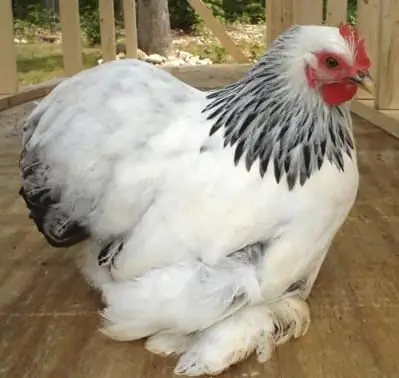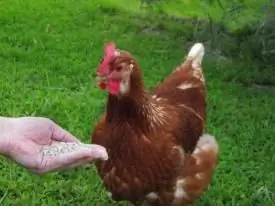2025 Author: Howard Calhoun | [email protected]. Last modified: 2025-01-24 13:10:45
After planning and successfully starting a homemade chicken egg business, you have many questions on your mind. First of all, a novice farmer is interested in how to feed laying hens, how to organize a room for them and maintain a regimen in it. All this is not so difficult, not very expensive and, since there is a constant demand for products, it is certainly profitable. Let's talk more about feeding poultry.
How to feed laying hens

Egg-laying hen's diet should be complete and include plant-based (both whole grain and flour mixtures), animal feed and minerals. How to feed laying hens if you have a breeding stock of a bird from which you receive eggs for incubation of young animals? In feed for them, there should be a high content of easily digestible protein and vitamins (B, E). Sprouted grains become the source of vitamin E, yeast is the source of B vitamins. This category of poultry also needs fish oil in their diet.
What feeds are used for laying hens
For this, cereals, legumes, cakes and meals in the form of concentrates are used. Also needed are fish, meat and bone meal, milk, cottage cheese, green grass, carrots, beets, potatoes, bran, pine flour, limestone, chalk, feed phosphates, s alt. Basically, the birds are fed with complete feed mixtures, in addition, food waste and vegetable tops are relevant. Mineral feed should always be in the house. Before the start of oviposition (two to three weeks in advance), a reserve of calcium must be created in the body of the bird. Egg laying of chickens is phase, the first stage is characterized by intensive production of eggs, it lasts from 21-22 weeks to 48 weeks, reaching a peak at 28-29. During this period, you need to feed the bird with high-calorie, low-volume feed. After 48 weeks, productivity and nutrient requirements drop.

In how to feed laying hens, feeding regimen is of great importance. Dry food is given twice a day. If wet mixers are used, then the frequency of meals is increased to three or four. At the same time, they make sure that the food is not in the feeders for more than 30-40 minutes.
Here is an approximate layout of what to feed laying hens (per head per day):
Grain - 50 g, flour mixture - 50 g, hay flour - up to 10 g, succulent feed (carrots, beets) - up to 50 g, dry protein feed - 10-15 g, chopped shell - 5 g, bone meal - 2 g, s alt - 0.5 g. The total amount of feed mixture per chicken per day is 120 g. Thus, the annual consumption will be about 44 kg. The volume of the dailyfeed when adding juicy and green feed to the diet - 170 g.
A bird needs about 250-300 g of water per head per day at a room temperature of 10 to 18oC.

A final word
The maintenance of laying hens at home, of course, differs from the industrial one: no even rows of cages, automatic drinkers, food distributors, harvesting units. But with home production, the farmer knows almost every chicken “by sight”, its features and problems. He can organize the case as efficiently as possible with this in mind. In the event of a poultry disease, it is easy for a farmer to notice this among a small population and respond promptly.
Recommended:
How to feed laying hens at home and on poultry farms?

The article tells how to properly feed laying hens to get as many eggs from them as possible
How to feed laying hens to rush better: features and recommendations

The ability of hens to lay eggs can vary depending on the time of year and climatic conditions. This feature is associated with the physiology of birds. Therefore, today many farmers are interested in the question of how to feed chickens in the cold?
Proper feeding of laying hens is the key to good productivity

Many of you keep a household: chickens, ducks, goats and maybe even pigs, but not many know how to properly feed these animals. In this article, you will learn what to feed chickens and how feeding laying hens affects their productivity
Laying hens: care and feeding

Laying hens, which differ in some nuances of care, are bred in the household for eggs and meat. To achieve good results, it is necessary to provide the bird with appropriate feeding and certain conditions of detention
Household incubator "Laying hen". Incubator "Laying hen": description, instruction, reviews. Comparison of the incubator "Laying hen" with analogues

"Laying hen" is an incubator, very popular among domestic owners of household plots. The use of these convenient, fully automatic devices allows you to achieve a hatchability of chicks up to at least 85%. Egg incubation takes almost no time

